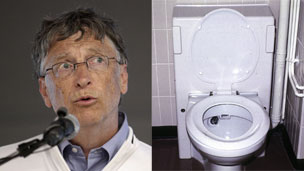Toilets of the future 未来的厕所
Vocabulary: Toilets, technology and sanitation 厕所,技术和公共卫生

Bill Gates has big plans for the toilets of the future.
One of the world’s richest men has taken a close interest in one of man’s most basic functions: visiting the toilet. Bill Gates’s charitable organisation, the Bill and Melinda Gates Foundation, is looking for inventors to design the loo of the future, which, they hope, would improve sanitation for millions of people around the world.
收听与下载
So, what’s wrong with the traditional flush toilet? Firstly, it wastes a huge amount of potential drinking water. This is a real problem in many areas of the developing world, where, according to United Nations estimates, unsafe sanitation causes half of all hospitalisations. Younger people are particularly at risk. Illnesses which cause diarrhoea are responsible for the deaths of about 1.5 million children a year. Secondly, standard lavatories simply aren’t practical in remote areas.
The challenge set by Bill Gates was to come up with a latrine which works without running water, electricity or a septic tank. It also needed to operate for less than 5 cents (0.3 RMB).
28 designs were displayed at the recent Reinvent the Toilet fair in Seattle, USA. Among them was one which turned poo into electricity using microwaves, another which converted excrement into charcoal, and yet another which used urine for flushing.
But the winner was a solar-powered design which generated hydrogen gas and electricity. The team from the California Institute of Technology picked up a prize of $100,000, almost 650,000 RMB.
But clearly Bill Gates doesn’t feel he’s flushing money down the toilet. After the Seattle event he said, “We couldn’t be happier with the response we’ve gotten.” Gates has even pledged $370m (2.2 billion RMB) more to the future toilet project. They hope to field test more prototypes over the next three years.
Glossary 词汇表 (点击单词收听发音)
- loo(英式俚语)一个厕所
- sanitation公共卫生条件或状况
- flush toilet抽水马桶
- hospitalisation住院
- diarrhoea腹泻
- lavatory盥洗室,厕所
- latrine 公共厕所
- septic tank化粪池
- poo大便
- excrement粪便
- charcoal木炭
- urine尿
- flushing冲洗
- solar-powered用太阳能驱动的
- hydrogen氢气
- flushing money down the toilet把钱从厕所冲下去,(比喻)浪费钱
- prototypes样机或模型